Estimating Yield Response Functions to Nitrogen for Annual Crops in Iran
Abstract
1. Introduction
2. Methodology
Data and Information
3. Results
4. Discussion
5. Conclusions
Author Contributions
Funding
Data Availability Statement
Conflicts of Interest
References
- Islamic Republic of Iran Customs Administration (IRICA). Annual Report for 2021. Tehran, Iran. Available online: https://irandataportal.syr.edu/ministry-of-agriculture (accessed on 20 February 2024).
- Iranian Agriculture Ministry-Jihad (IMAJ). The Cost of Agricultural Production Systems. Department of Planning and Support. Administration of Statistics 2021, Iran. Available online: https://irandataportal.syr.edu/ministry-of-agriculture (accessed on 20 February 2024).
- Ansari, V.; Hassani Diyarjan, F.; Salami, H. Effects of agricultural land dispersion and fragmentation on the cost of agricultural products. Iran. J. Agric. Econ. Dev. Res. 2020, 51, 393–412. (In Persian) [Google Scholar] [CrossRef]
- Aghabeygi, M.; Louhichi, K.; Gomez y Paloma, S. Impacts of fertilizer subsidy reform options in Iran-an assessment using a regional crop programming model. Bio-Based Appl. Econ. 2022, 11, 55–73. [Google Scholar] [CrossRef]
- Khorsandi, M.; Tayebeh, O.; Pieter, V. Water-related limits to growth for agriculture in Iran. Heliyon J. 2023, 9, e16132. [Google Scholar] [CrossRef] [PubMed]
- Hosseini, S.; Shahnabati, N. Considering the distributional effect of agricultural policies in provinces of Iran. J. Agric. Econ. 2015, 9, 1–18. (In Persian) [Google Scholar]
- Saeediankia, A.; Emamgholipour, S.; Pouraram, H.; Mousavi, A.; Majdzadeh, R. Impact of targeted subsidies reform on household nutrition: Lessons learned from Iran. Iran. J. Public Health 2023, 52, 1504–1513. [Google Scholar] [CrossRef] [PubMed]
- Govindasamy, P.; Muthusamy, S.K.; Bagavathiannan, M. Nitrogen use efficiency—A key to enhance crop productivity under a changing climate. Front. Plant Sci. 2023, 14, 1121073. [Google Scholar] [CrossRef] [PubMed]
- Abdollahzadeh, G.H.; Sharif Sharifzadeh, M.; Sklenička, P.; Azadi, H. Adaptive capacity of farming systems to climate change in Iran: Application of composite index approach. Agric. Syst. 2023, 204, 103537. [Google Scholar] [CrossRef]
- Roozitalab, M.; Siadat, H.; Farshad, A. (Eds.) The Soils of Iran; World Soils Book Series; Springer: Cham, Swtizerland, 2018. [Google Scholar] [CrossRef]
- Hosseini, M.J.; Dezhangah, S.; Esmi, F.; Gharavi-nakhjavani, M.; Hashempour-baltork, F.; Mirza Alizadeh, A. A worldwide systematic review, meta-analysis and meta-regression of nitrate and nitrite in vegetables and fruits. Ecotoxicol. Environ. Saf. 2023, 257, 114934. [Google Scholar] [CrossRef] [PubMed]
- Lopez, G.; Ahmadi, S.H.; Amelung, W.; Athmann, M.; Ewert, F.; Gaiser, T.; Gocke, M.I.; Kautz, T.; Postma, J.; Rachmilevitch, S.; et al. Nutrient deficiency effects on root architecture and root-to-shoot ratio in arable crops. Front. Plant Sci. 2023, 13, 1067498. [Google Scholar] [CrossRef]
- Keikha, M.; Darzi- Naftchali, A.; Motevali, A.; Valipour, M. Effect of nitrogen management on the environmental and economic sustainability of wheat production in different climates. Agric. Water Manag. 2023, 276, 108060. [Google Scholar] [CrossRef]
- Dhakal, C.; Lange, K. Crop yield response functions in nutrient application: A review. Agron. J. 2021, 113, 5222–5234. [Google Scholar] [CrossRef]
- Davies, B.; Coulter, J.A.; Pagliari, P.H. Timing and rate of nitrogen fertilization influence maize yield and nitrogen use efficiency. PLoS ONE 2020, 15, e0233674. [Google Scholar] [CrossRef]
- Song, Q.; Fu, H.; Shi, Q.; Shan, X.; Wang, Z.; Sun, Z.; Li, T. Over fertilization reduces tomato yield under long-term continuous cropping system via regulation of soil microbial community composition. Front. Microbiol. 2022, 13, 952021. [Google Scholar] [CrossRef]
- Yuan, D.; Hu, Y.; Jia, S.; Li, W.; Zamanian, K.; Han, J.; Huang, F.; Zhao, X. Microbial properties depending on fertilization regime in agricultural soils with different texture and climate conditions: A meta-analysis. Agronomy 2023, 13, 764. [Google Scholar] [CrossRef]
- Yousaf, M.; Li, X.; Zhang, Z.; Ren, T.; Cong, R.; Ata-Ul-Karim, S.T.; Fahad, S.; Shah, A.N.; Lu, J. Nitrogen fertilizer management for enhancing crop productivity and nitrogen use efficiency in a rice-oilseed rape rotation system in China. Front. Plant Sci. 2016, 7, 1496. [Google Scholar] [CrossRef] [PubMed]
- Smith, R.G.; Gross, K.L.; Robertson, G.P. Effects of Crop Diversity on Agroecosystem Function: Crop Yield Response. Ecosystems 2008, 11, 355–366. [Google Scholar] [CrossRef]
- Hua, S.; Dal-Bianco, M.; Chen, Z.H. Editorial: Crop Yield and Quality Response to the Interaction between Environment and Genetic Factors. Front. Genet. 2022, 13, 823279. [Google Scholar] [CrossRef]
- Jeong, J.H.; Resop, J.P.; Mueller, N.D.; Fleisher, D.H.; Yun, K.; Butler, E.E.; Timlin, D.J.; Shim, K.M.; Gerber, J.S.; Reddy, V.R.; et al. Random Forests for Global and Regional Crop Yield Predictions. PLoS ONE 2016, 11, e0156571. [Google Scholar] [CrossRef]
- Trevisan, R.G.; Bullock, D.S.; Martin, N.F. Spatial Variability of Crop Responses to Agronomic Inputs in on-Farm Precision Experimentation. Precis. Agric. 2021, 22, 342–363. [Google Scholar] [CrossRef]
- Steduto, P.; Hsiao, T.C.; Fereres, E.; Raes, D. Crop Yield Response to Water; Food and Agriculture Organization of the United Nations: Roma, Italy, 2012; ISBN 978-92-5-107274-5. [Google Scholar]
- Griffin, R.C.; Montgomery, J.M.; Rister, M.E. Selecting functional form in production function analysis. West. J. Agric. Econ. 1987, 12, 216–227. [Google Scholar]
- Tesfahunegn, G.B.; Wortmann, C.S. User Guide to Development of Predictive Equations for Crop-Nutrient Response Coefficients from Field Research Data: An OFRA Working Document; OFRA Project; The Alliance for a Green Revolution in Africa (AGRA): Addis Ababa, Ethiopia, 2016. [Google Scholar]
- Wooldridge, J.M. Correlated random effects models with unbalanced panels. J. Econom. 2019, 211, 137–150. [Google Scholar] [CrossRef]
- Ke, L.; Hanzhong, L. Testing for individual and time effects in unbalanced panel data models with time-invariant regressors. Electron. Res. Arch. 2022, 30, 4574–4592. [Google Scholar] [CrossRef]
- Baltagi, B.H.; Lui, L. Forecasting with unbalanced panel data. J. Forecast. 2020, 39, 709–724. [Google Scholar] [CrossRef]
- Czarnowske, D.; Stammann, A. Inference in Unbalanced Panel Data Models with Interactive Fixed Effects. arXiv 2020, arXiv:2004.03414. [Google Scholar] [CrossRef]
- Gnecco, G.; Nutarelli, F.; Selvi, D. Optimal trade-off between sample size, precision of supervision, and selection probabilities for the unbalanced fixed effects panel data model. Soft Comput. 2020, 24, 15937–15949. [Google Scholar] [CrossRef]
- Joshi, R.; Wooldridge, J.M. Correlated random effects models with endogenous explanatory variables and unbalanced panels. Ann. Econ. Stat. 2019, 134, 243–268. [Google Scholar] [CrossRef]
- Lee, Y.; Okui, R. Hahn–Hausman test as a specification test. J. Econom. 2012, 167, 133–139. [Google Scholar] [CrossRef]
- Louhichi, K.; Gomez y Paloma, S. A farm household model for agri-food policy analysis in developing countries: Application to smallholder farmers in Sierra Leone. Food Policy 2014, 45, 1–13. [Google Scholar] [CrossRef]
- Merel, P.; Simon, L.K.; Yi, F. A Fully Calibrated Generalized Constant-Elasticity-of-Substitution Programming Model of Agricultural Supply. Am. J. Agric. Econ. 2011, 93, 936–948. [Google Scholar] [CrossRef]
- Merel, P.; Yi, F.; Lee, J.; Six, J. A Regional Bioeconomic Model of Nitrogen Use in Cropping. Am. J. Agric. Econ. 2013, 96, 67–91. [Google Scholar] [CrossRef]
- Graveline, N.; Merel, P. Intensive and Extensive Margin Adjustments to Water Scarcity in France’s Cereal Belt. Eur. Rev. Agric. Econ. 2014, 41, 707–743. [Google Scholar] [CrossRef]
- He, M.; Kimball, J.S.; Maneta, M.P.; Maxwell, B.D.; Moreno, A.; Beguería, S.; Wu, X. Regional Crop Gross Primary Productivity and Yield Estimation Using Fused Landsat-MODIS Data. Remote Sens. 2018, 10, 372. [Google Scholar] [CrossRef]
- Nyéki, A.; Neményi, M. Crop Yield Prediction in Precision Agriculture. Agronomy 2022, 12, 2460. [Google Scholar] [CrossRef]
- Xu, H.; Huang, F.; Zuo, W.; Tian, Y.; Zhu, Y.; Cao, W.; Zhang, X. Impacts of Spatial Zonation Schemes on Yield Potential Estimates at the Regional Scale. Agronomy 2020, 10, 631. [Google Scholar] [CrossRef]
- Razeghi, F.; Haghi, E.; Yunesian, M. Data about knowledge and tendency towards organic foods use in Tehran. Data Brief. 2018, 16, 955–958. [Google Scholar] [CrossRef]
- Eyshi Rezaie, E.; Ghazaryan, G.; Moradi, R.; Dubovyk, O.; Siebert, S. Crop harvested area, not yield, drives variability in crop production in Iran. Environ. Res. Lett. 2021, 16, 064058. [Google Scholar] [CrossRef]
- Dadrasi, A.; Chaichi, M.; Nehbandani, A.; Soltani, E.; Nemati, A.; Salmani, F.; Heydari, M.; Yousefi, A.R. Global insight into understanding wheat yield and production through Agro-Ecological Zoning. Sci. Rep. 2023, 13, 15898. [Google Scholar] [CrossRef]
- Zhang, H.; Yu, C.; Kong, X.; Hou, D.; Gu, J.; Liu, L.; Wang, Z.; Yang, J. Progressive integrative crop managements increase grain yield, nitrogen use efficiency and irrigation water productivity in rice. Field Crops Res. 2018, 215, 1–11. [Google Scholar] [CrossRef]
- Deihimfard, R.; Rahimi-Moghaddam, S.; Collins, B.; Azizi, K. Future climate change could reduce irrigated and rainfed wheat water footprint in arid environments. Sci. Total Environ. 2022, 807, 150991. [Google Scholar] [CrossRef] [PubMed]
- Faramarzi, M.; Yang, H.; Schulin, R.; Abbaspour, K.C. Modeling wheat yield and crop water productivity in Iran: Implications of agricultural water management for wheat production. Agric. Water Manag. 2010, 97, 1861–1875. [Google Scholar] [CrossRef]
- Eyshi Rezaie, E.; Bannayan, M. Rainfed wheat yields under climate change in north-eastern Iran. Meteorol. Appl. 2012, 19, 346–354. [Google Scholar] [CrossRef]
- Nazari, M.; Mirgol, B.; Salehi, H. Climate change impact assessment and adaptation strategies for rain-fed wheat in contrasting climatic regions of Iran. Front. Agron. 2021, 3, 806146. [Google Scholar] [CrossRef]
- Hosseini, R.A.; Soltani, A.; Ajamnorozi, H.; Zahed, M. The Impact of Climate Change on Rain-Fed Wheat Yield in Iran. Arab. J. Geosci. 2021, 14, 1961. [Google Scholar] [CrossRef]
- Ghamghami, M.; Beiranvand, J.P. Rainfed Crop Yield Response to Climate Change in Iran. Reg. Envrion. Change 2022, 22, 3. [Google Scholar] [CrossRef]
- Zarakani, F.; Kamali, G.; Chizari, A. The effect of climate change on the economy of rain fed wheat (a case study in Northern Khorasan). J. Agroecol. 2014, 6, 301–310. [Google Scholar] [CrossRef]
- Alasti, O.; Zeinali, E.; Soltani, A.; Torabi, B. Exploring the current status of barley yield and production gap of Iran. Eur. J. Agron. 2022, 139, 126547. [Google Scholar] [CrossRef]
- Khoshsirat, A.M.; Najarchi, M.; Jafarinia, R.; Mokhtari, S. Sensitivity analysis and determination of the optimal level of water use efficiency for winter wheat and barley under different irrigation scenarios using the aqua crop model in arid and semiarid climatic conditions (case study: Dehloran Plain, Iran). Water 2022, 14, 3455. [Google Scholar] [CrossRef]
- Ghahremaninejad, F.; Hoseini, E.; Jalali, S. The Cultivation and Domestication of Wheat and Barley in Iran, Brief Review of a Long History. Bot. Rev. 2021, 87, 1–22. [Google Scholar] [CrossRef]
- Fayazi, H.; Ebrahim, Z.; Soltani, A.; Torabi, B. Estimation of the Yield Potential and Yield Gap of Maize (Zea Mayz L.) in Iran Based on the Global Yield Gap Atlas Protocol (Gyga). 2023. Available online: https://ssrn.com/abstract=4397018 (accessed on 20 February 2024).
- Moradi, R.; Koocheki, A.; Nassiri Mahallati, M.; Mansoori, H. Adaptation strategies for maize cultivation under climate change in Iran: Irrigation and planting date management. Mitig. Adapt. Strat. Glob. Change 2013, 18, 265–284. [Google Scholar] [CrossRef]
- Saei, M.; Mohammadi, H.; Ziaee, S.; Barkhordari, S. The impact of climate change on grain yield and yield variability in Iran. Iran. Econ. Rev. 2019, 23, 509–531. [Google Scholar] [CrossRef]
- Karandish, F. Socioeconomic benefits of conserving Iran’s water resources through modifying agricultural practices and water management strategies. Ambio 2021, 50, 1824–1840. [Google Scholar] [CrossRef] [PubMed]
- Rahimi Jahangirlou, M.; Akbari, G.A.; Alahdadi, I.; Soufizadeh, S.; Kumar, U.; Parsons, D. Phenotypic Traits, Grain Yield and Yield Components of Maize Cultivars under Combinations of Management Practices in Semi-arid Conditions of Iran. Int. J. Plant Prod. 2021, 15, 459–471. [Google Scholar] [CrossRef]
- Lashkari, A.; Alizadeh, A.; Rezaei, E.E.; Bannayan, M. Mitigation of Climate Change Impacts on Maize Productivity in Northeast of Iran: A Simulation Study. Mitig. Adapt. Strat. Glob. Change 2012, 17, 1–16. [Google Scholar] [CrossRef]
- Moradi, R.; Koocheki, A.; Nassiri Mahallati, M. Adaptation of Maize to Climate Change Impacts in Iran. Mitig. Adapt. Strat. Glob. Change 2014, 19, 1223–1238. [Google Scholar] [CrossRef]
- Rashidi, M.; Gholami, M.; Khabbaz, B.G. Response of yield and yield components of tomato (Lycopersicon esculentum) to different tillage methods. Int. J. Agric. Biol. 2009, 11, 626–630. [Google Scholar]
- Ronga, D.; Pentangelo, A.; Parisi, M. Optimizing N fertilization to improve yield, technological and nutritional quality of tomato grown in high fertility soil conditions. Plants 2020, 9, 575. [Google Scholar] [CrossRef] [PubMed]
- Bazarfshan, O.; Yahyazadeh, M.; Jamshidi, S.; Zamani, H. Spatial prioritization of tomato cultivation based on water footprint, land productivity, and economic indices. Irrig. Draing J. 2022, 71, 1363–1378. [Google Scholar] [CrossRef]
- Sasidharan, S. The Processing Tomato Industry in Iran—Part 1. Tomato News. 2021. Available online: https://www.tomatonews.com/en/the-processing-tomato-industry-in-iran--part1_2_1412.html (accessed on 14 February 2024).
- Rezaei, M.E.; Barmaki, M.; Veisi, H. Environmental impact assessment (EIA) of alternative potato cropping systems in Hamadan Province, Iran. Appl. Ecol. Envrion. Res. 2018, 16, 535–552. [Google Scholar] [CrossRef]
- Dadrasi, A.; Torabi, B.; Rahimi, A.; Soltani, A.; Zeinali, E. Modeling potential production and yield gap of potato using modelling and GIS approaches. Ecol. Model. 2022, 471, 110050. [Google Scholar] [CrossRef]
- Rahemi, M.; Hasanpour, A.; Mansoori, B.; Zakerin Taghavi, T. The effects of intra-row spacing and N fertilizer on the yield of two foreign potato cultivars in Iran. Int. J. Agric. Biol. 2005, 7, 705–707. [Google Scholar]
- Abdolmaleky, M.; Mahdei, K.N.; Nejatian, P. Environmental Sustainability Assessment: Potato Production in Western Iran. Process Integr. Optim. Sustain. 2022, 6, 1063–1073. [Google Scholar] [CrossRef]
- Imani, B.; Allahyari, M.S.; Bondori, A.; Emami, N.; El Bilali, H. Adoption of Organic Potato Production in Ardabil Plain, Iran: An Application of the Extended Theory of Planned Behaviour. Potato Res. 2021, 64, 177–195. [Google Scholar] [CrossRef]
- Mohammadi, F.M.; Hassanpour Asil, M. Onion yield, quality and storability as affected with different soil moisture and nitrogen regimes. South. West. J. 2012, 3, 145–165. [Google Scholar]
- Elhami, B.; Ghasemi Nejad Raeini, M.; Taki, M.; Marzban, A.; Heidarisoltanabadi, M. Application of classic and soft computing for modeling yield and environmental final impact in vegetable production (a case study: Transplanting onion in Isfahan province, Iran). Envrion. Sci. Pollut. Res. Int. 2022, 29, 35314–35337. [Google Scholar] [CrossRef]
- Esmaeilzadeh, S.; Asgharipour, M.R.; Khoshnevisan, B. Water footprint and life cycle assessment of edible onion production—A case study in Iran. Sci. Hortic. 2020, 261, 108925. [Google Scholar] [CrossRef]
- Mousavi Avval, S.H.; Rafiee, S.; Jafari, A.; Mohammadi, A. Energy flow modelling and sensitivity analysis of inputs for canola production in Iran. J. Clean. Prod. 2011, 19, 1464–1470. [Google Scholar] [CrossRef]
- Zarafshani, K.; Ghasemi, S.; Houshyar, E.; Ghanbari, R.; Van Passel, S.; Azadi, H. Canola Adoption Enhancement in Western Iran. J. Agr. Sci. Technol. 2017, 19, 47–58. [Google Scholar]
- Khanali, M.; Mousavi, S.A.; Sharifi, M.; Keyhani Nasab, F.; Chau, K.W. Life cycle assessment of canola edible oil production in Iran: A case study in Isfahan province. J. Clean. Prod. 2018, 196, 714–725. [Google Scholar] [CrossRef]
- Dayananda, B.; Fernandez, M.R.; Lokuruge, P.; Zentner, R.P.; Schellenberg, M.P. Economic Analysis of Organic Cropping Systems Under Different Tillage Intensities and Crop Rotations. Renew. Agric. Food Syst. 2021, 36, 509–516. [Google Scholar] [CrossRef]
- Strauss, V.; Paul, C.; Dönmez, C.; Löbmann, M.; Helming, K. Sustainable Soil Management Measures: A Synthesis of Stakeholder Recommendations. Agron. Sustain. Dev. 2023, 43, 117. [Google Scholar] [CrossRef]
- Global Yield Gap and Water Productivity Atlas. Available online: http://www.yieldgap.org (accessed on 24 January 2023).


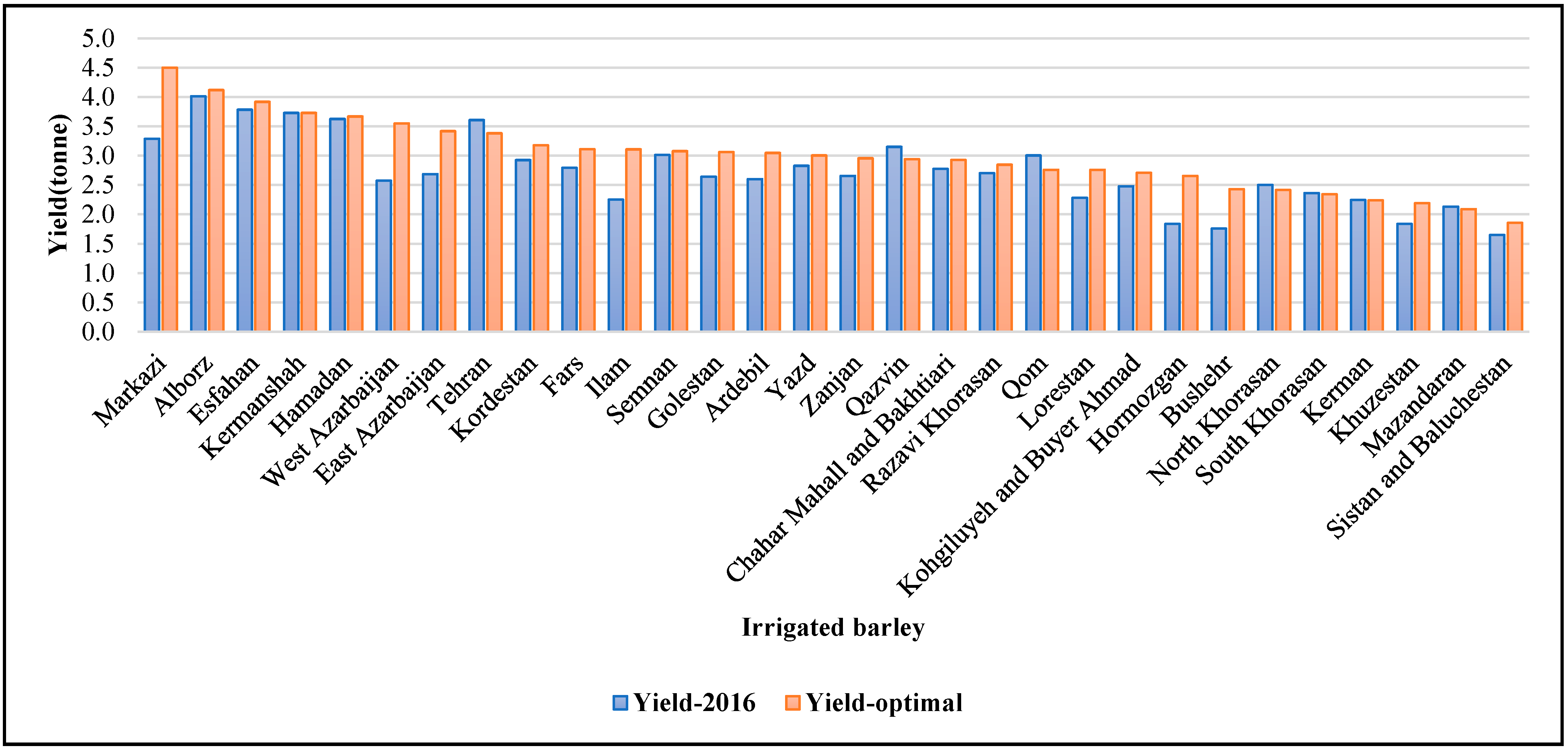
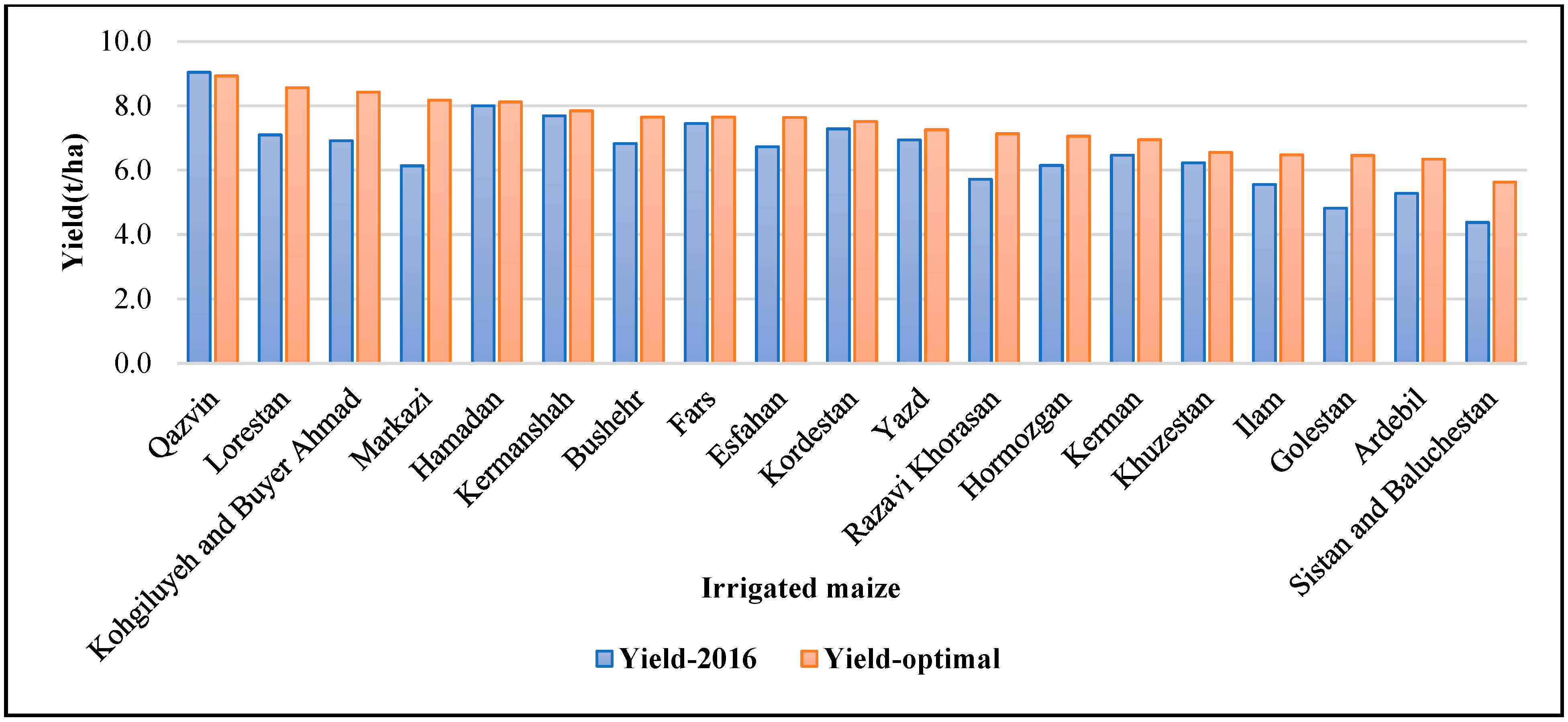
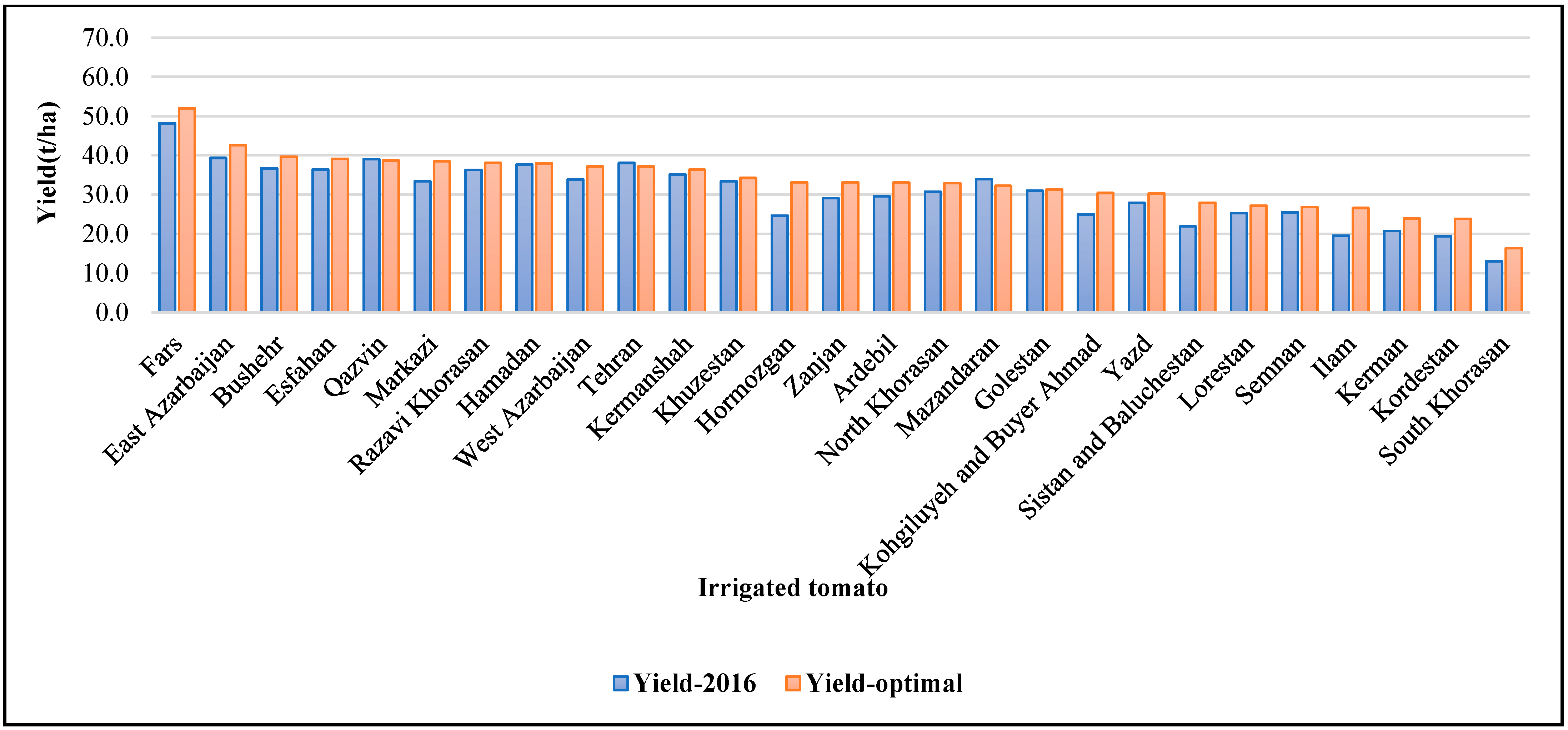
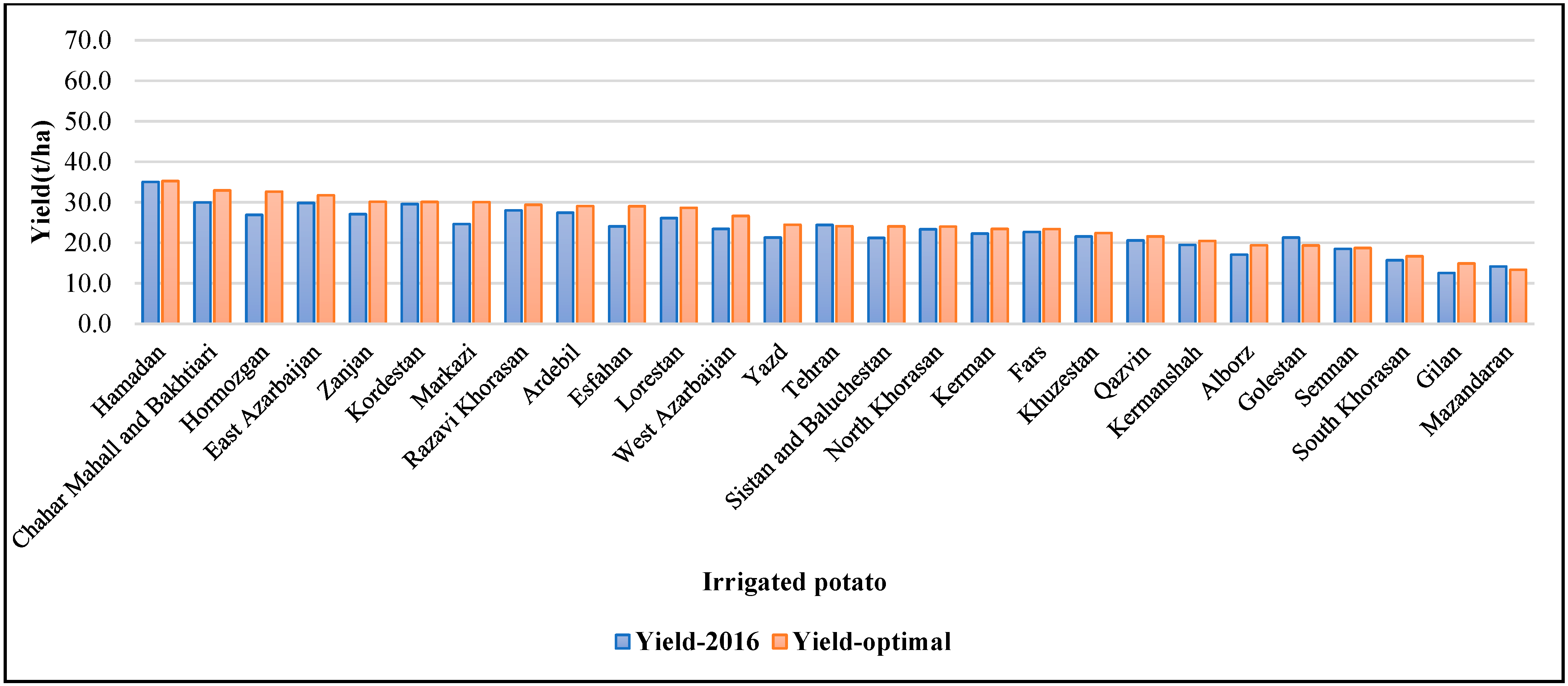

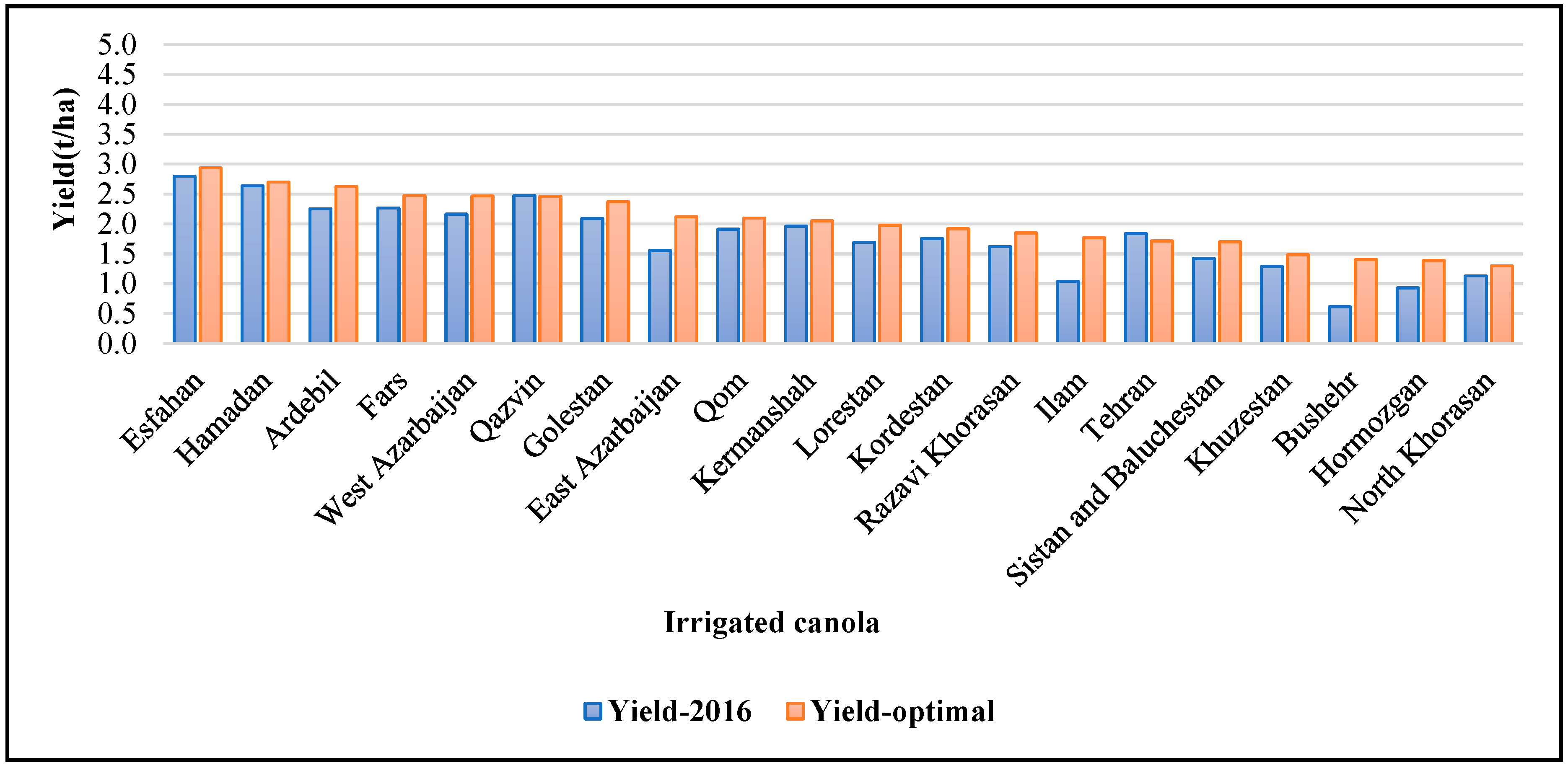



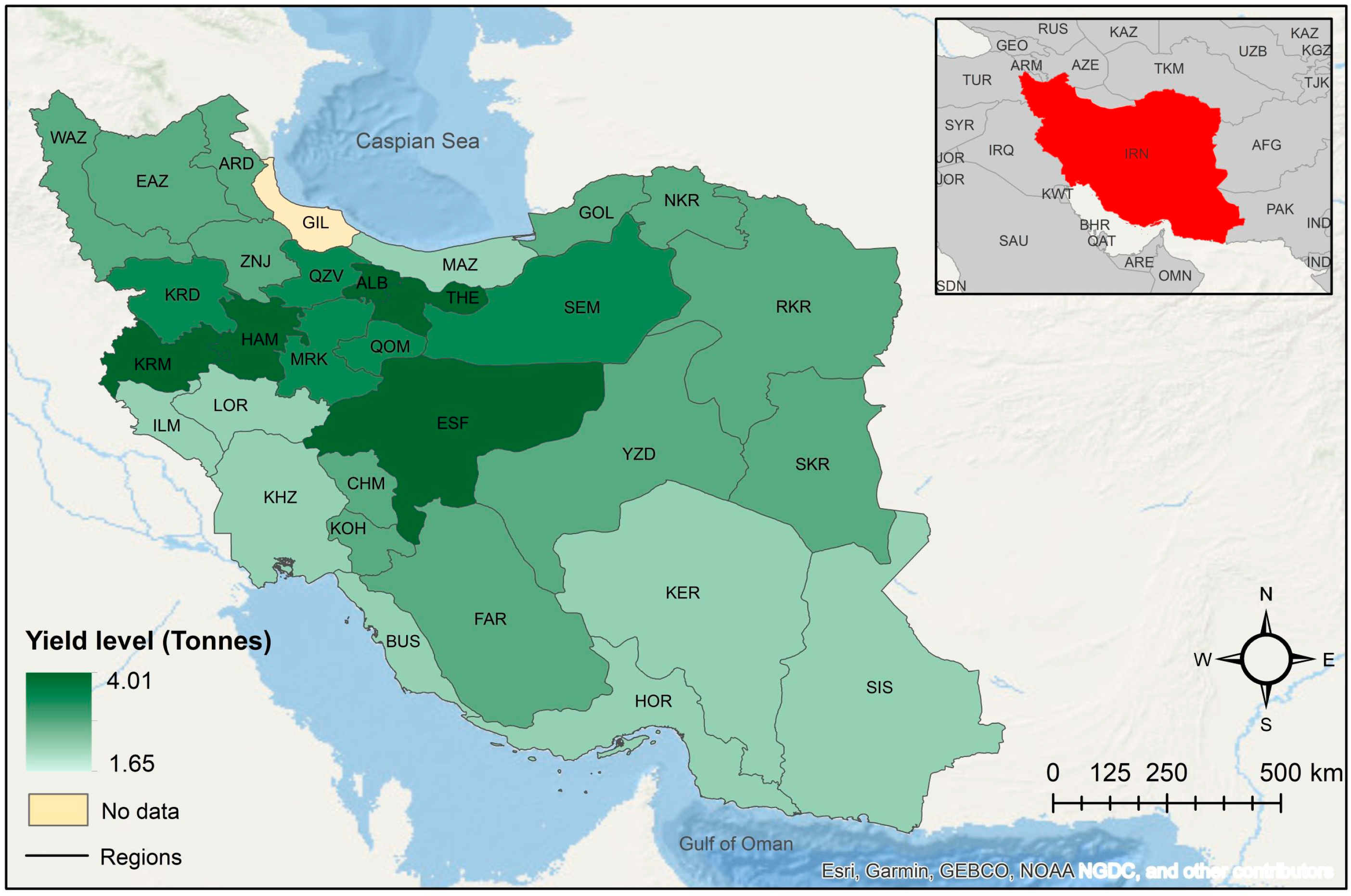

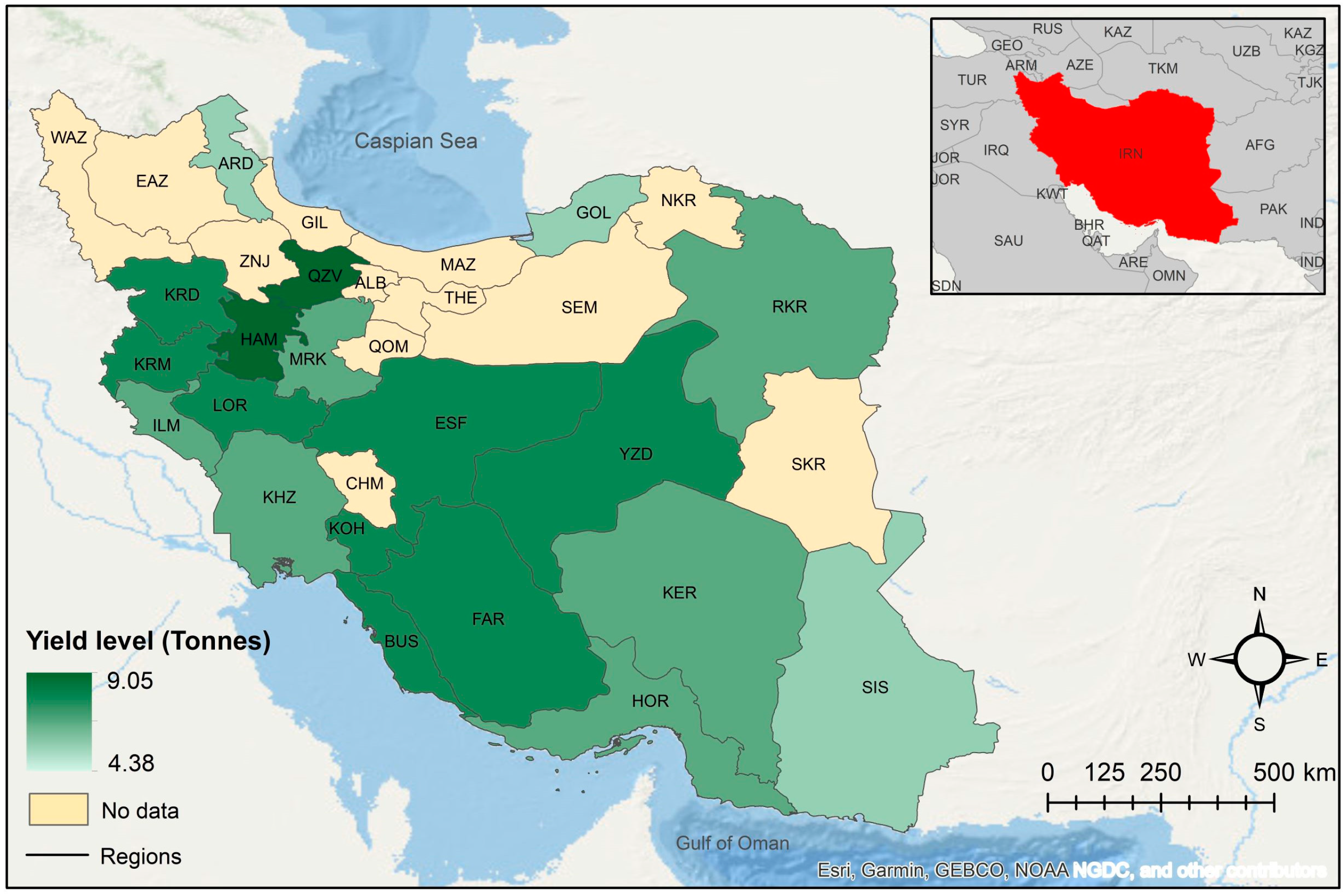
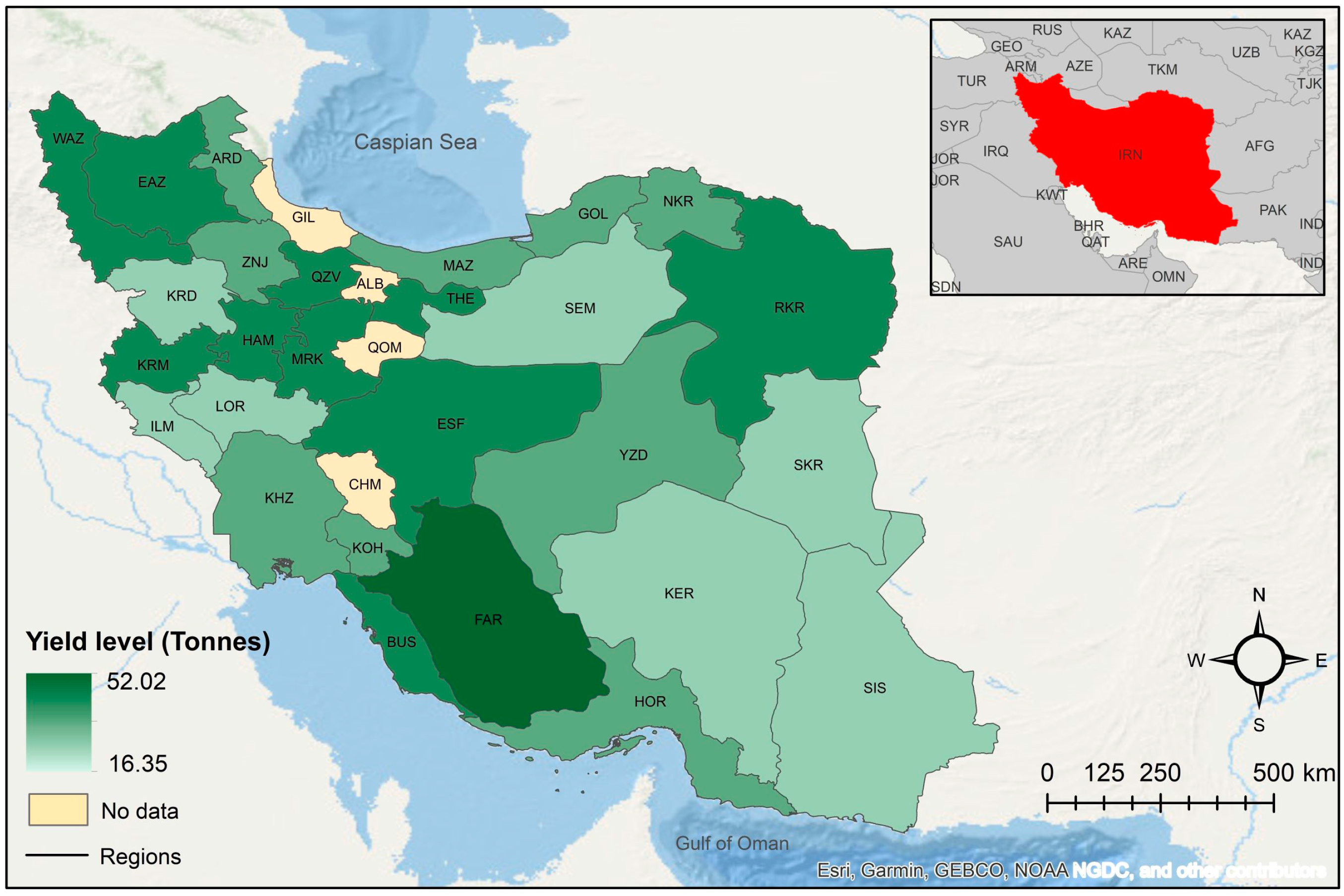

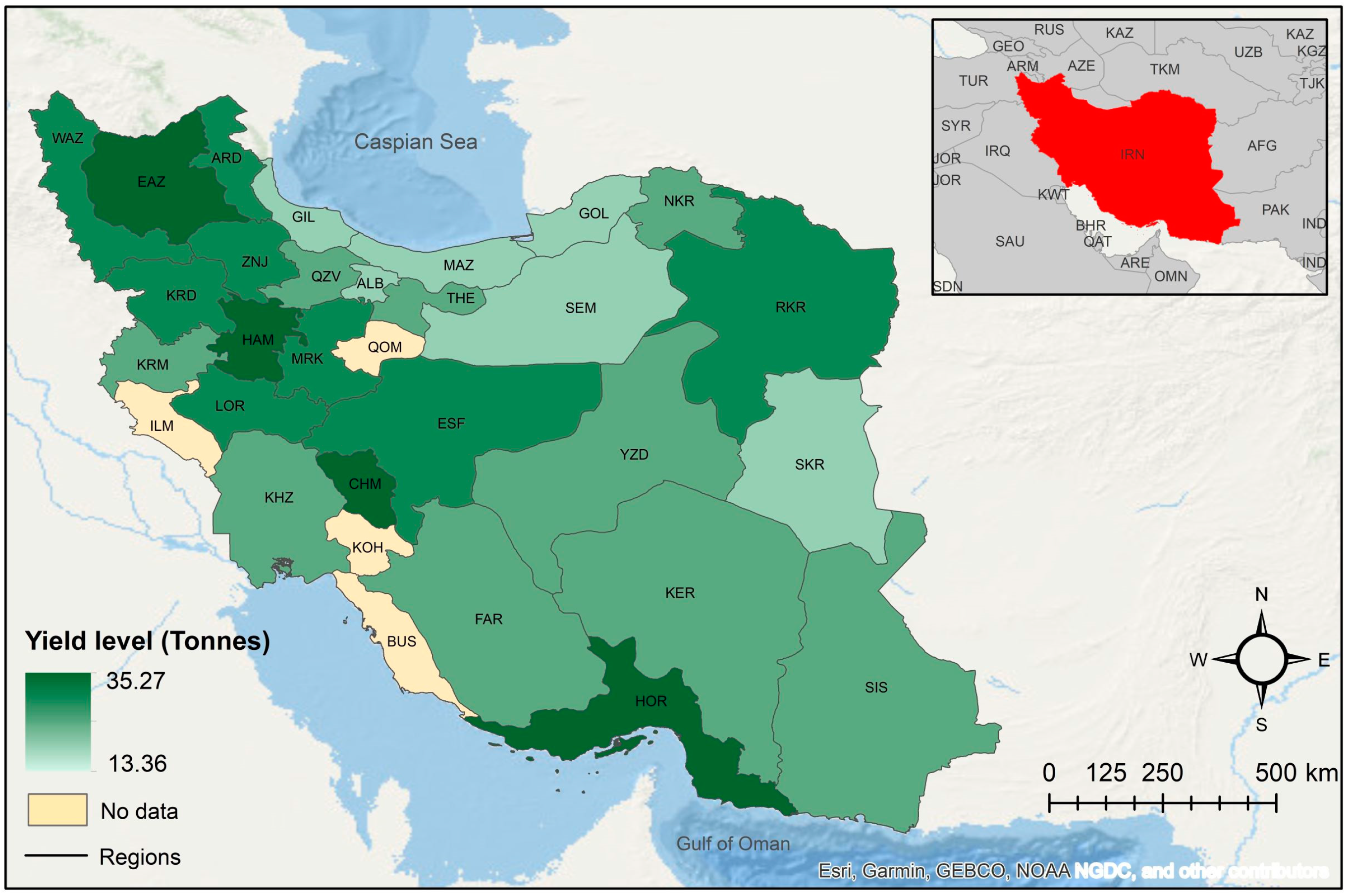
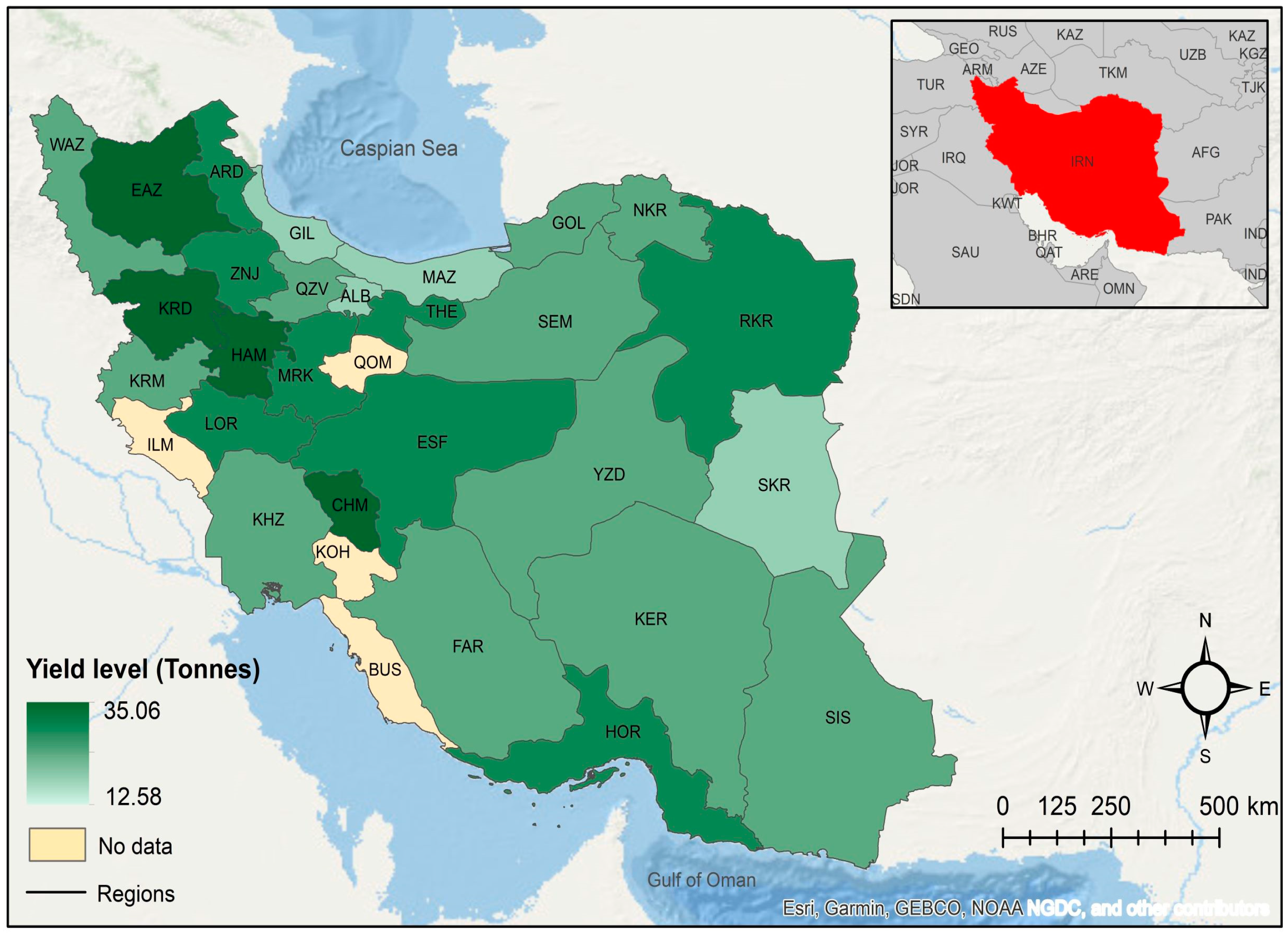
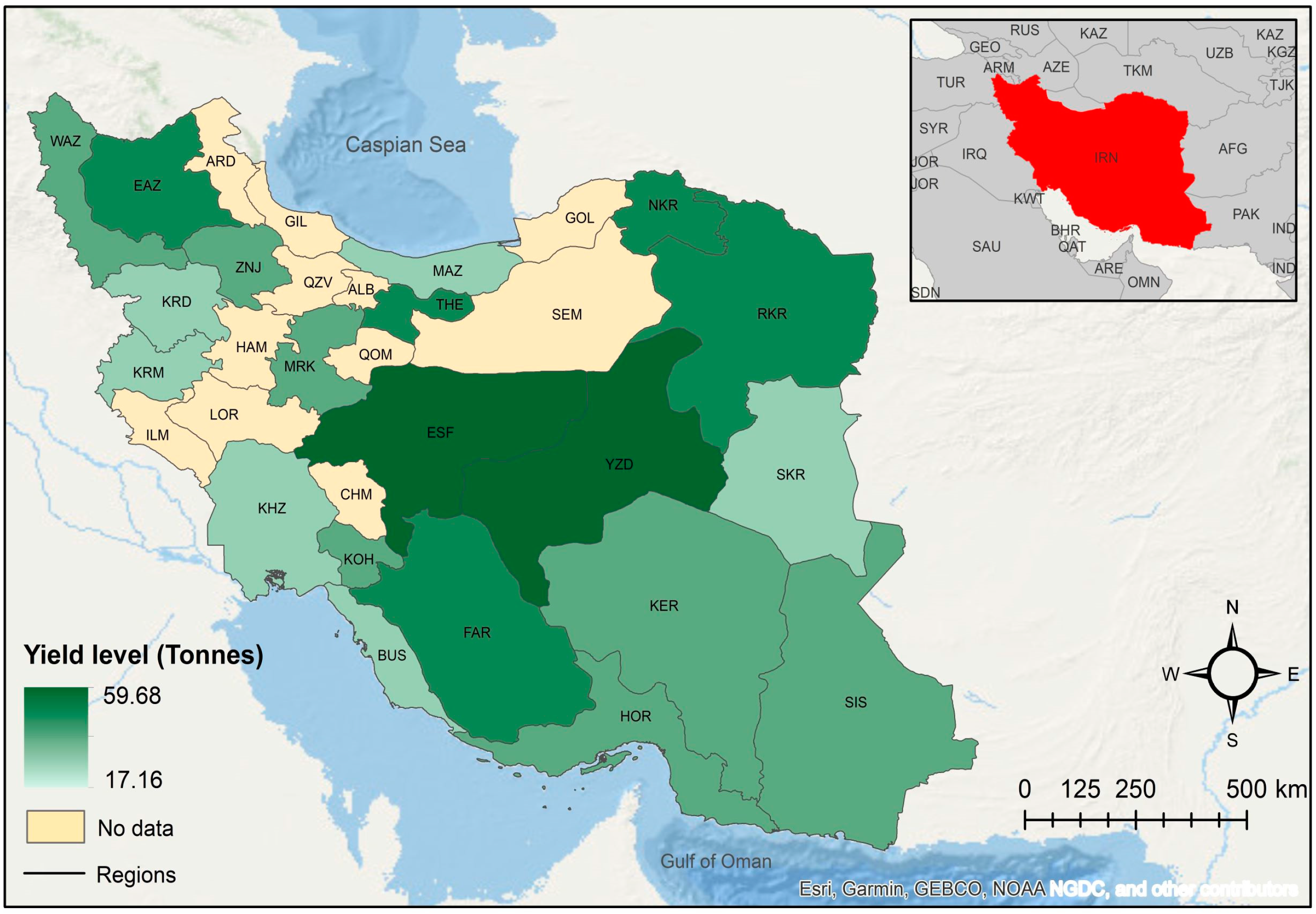


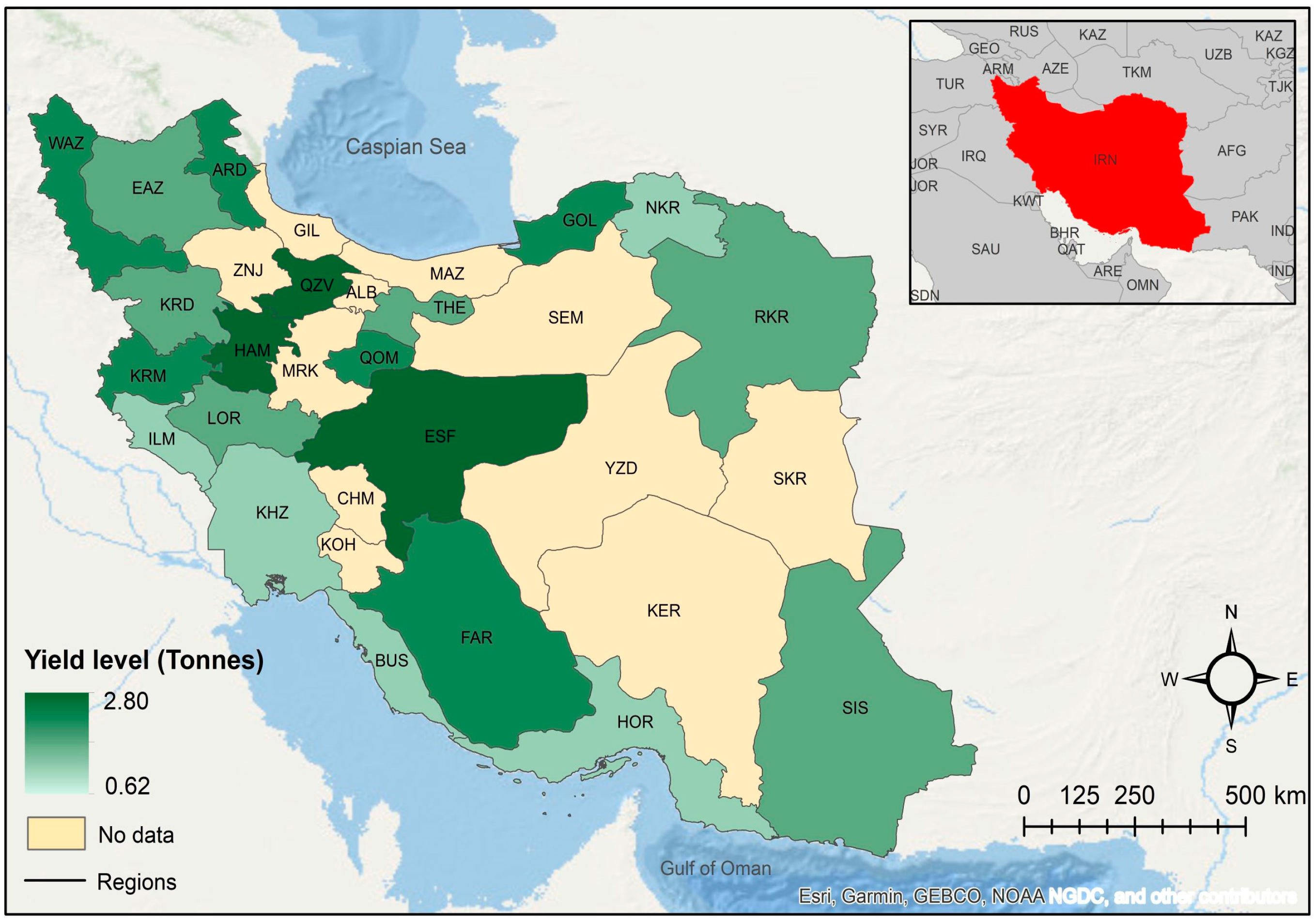
| Group | Crops | Area under Cultivation (1000 ha) | Production (1000 ton) | Yield (t/ha) | Fertilizer Use 1 (kg/ha) | Nitrate Use (kg/ha) | Nitrate Contribution from Fertilizer (%) |
|---|---|---|---|---|---|---|---|
| Cereals | Wheat | 5894.07 | 12,117.70 | 2.06 | 302.02 | 194.46 | 64.39 |
| Barley | 1739.84 | 3281.66 | 1.89 | 171.97 | 110.06 | 64.00 | |
| Rice | 332.58 | 1737.17 | 5.22 | 1127.29 | 695.03 | 61.65 | |
| Maize | 173.53 | 1249.70 | 7.20 | 677.63 | 441.84 | 65.20 | |
| Legumes | Peas | 492.56 | 236.67 | 0.48 | 18.49 | 11.45 | 61.93 |
| Lentils | 134.57 | 74.71 | 0.56 | 5.13 | 3.36 | 65.50 | |
| Vegetables | Tomato | 118.76 | 4878.06 | 41.08 | 676.35 | 427.57 | 63.22 |
| Potato | 148.45 | 4726.75 | 31.84 | 620.01 | 371.17 | 59.87 | |
| Onion | 50.16 | 1861.46 | 37.11 | 1033.77 | 629.38 | 60.88 | |
| Industrial | Sugar beet | 100.66 | 5278.90 | 52.44 | 587.20 | 350.48 | 59.69 |
| Canola | 60.01 | 93.63 | 1.56 | 425.24 | 259.02 | 60.91 | |
| Cotton | 72.09 | 166.30 | 2.31 | 132.61 | 81.2 | 61.23 | |
| Melons | Cucumber | 46.25 | 1007.52 | 21.78 | 307.87 | 209.55 | 68.06 |
| Watermelon | 112.39 | 3099.80 | 27.58 | 487.34 | 288.78 | 59.26 | |
| MIN | 46.25 | 74.71 | 0.48 | 288.78 | 3.36 | 59.26 | |
| MAX | 5894.07 | 12,117.70 | 52.44 | 1127.29 | 695.03 | 68.06 | |
| STDEV | 1564.68 | 3248.38 | 18.14 | 345.43 | 211.90 | 2.58 | |
| Group | Crop | Technology | ) | Fixed Effect/Random Effect |
|---|---|---|---|---|
| Cereals | Wheat | Rain-fed | 46.23 (0.00) * | Fixed effect |
| Irrigated | 6.43 (0.02) * | Random effect | ||
| Barley | Rain-fed | 4.84 (0.08) ** | Random effect | |
| Irrigated | 13.75 (0.00) * | Fixed effect | ||
| Rice | Irrigated | 5.89 (0.03) * | Random effect | |
| Maize | Irrigated | 16.28 (0.00) * | Fixed effect | |
| Legumes | Peas | Rain-fed | 12.13 (0.00) * | Fixed effect |
| Irrigated | 14.53 (0.00) * | Fixed effect | ||
| Lentils | Rain-fed | 21.34 (0.00) * | Fixed effect | |
| Irrigated | 5.10 (0.05) ** | Random effect | ||
| Vegetables | Tomato | Irrigated | 20.76 (0.00) * | Fixed effect |
| Potato | Irrigated | 12.53 (0.00) * | Fixed effect | |
| Onion | Irrigated | 19.23 (0.00) * | Fixed effect | |
| Industrial | Sugar beet | Irrigated | 10.28 (0.03) * | Random effect |
| Canola | Rain-fed | 17.05 (0.00) * | Fixed effect | |
| Irrigated | 11.01 (0.01) * | Fixed effect | ||
| Cotton | Irrigated | 9.05 (0.05) ** | Random effect | |
| Melons | Cucumber | Irrigated | 6.52 (0.08) ** | Random effect |
| Watermelon | Rain-fed | 7.10 (0.07) ** | Random effect | |
| Irrigated | 8.02 (0.05) ** | Fixed effect |
| Group | Crop | Technology | Intercept | Rainfall | ||
|---|---|---|---|---|---|---|
| Cereals | Wheat 3 | Rain-fed | - 1 | 0.53 (0.18) *2 | 10.10 (1.98) * | −0.031 (0.013) * |
| Irrigated | 1915.70 (475.29) * | 1.11 (0.33) * | 5.86 (4.46) | −0.004 (0.011) | ||
| Barley | Rain-fed | 539.61 (76.72) * | 0.40 (0.11) * | 4.80 (1.64) * | −0.010 (0.006) *** | |
| Irrigated | - | 1.85 (0.36) * | 18.07 (2.14) * | −0.045 (0.007) * | ||
| Rice | Irrigated | 3299.83 (363.61) * | 0.84 (0.57) *** | 1.86 (1.11) *** | −0.001 (0.0004) * | |
| Maize | Irrigated | - | 3.84 (0.83) * | 20.27 (1.70) * | −0.021 (0.002) * | |
| Legumes | Peas | Rain-fed | - | 0.64 (0.09) * | 2.27 (1.22) ** | −0.008 (0.010) |
| Irrigated | - | 2.55 (0.42) * | 1.84 (1.50) | −0.003 (0.005) | ||
| Lentils | Rain-fed | - | 0.44 (0.08) * | 0.27 (1.67) | −0.018 (0.016) | |
| Irrigated | 974.40 (105.35) * | 0.08 (0.16) | 1.04 (1.20) | −0.001 (0.004) | ||
| Vegetables | Tomato | Irrigated | - | 23.78 (4.77) * | 57.92 (8.29) * | −0.058 (0.010) * |
| Potato | Irrigated | - | 18.75 (3.39) * | 53.71 (6.57) * | −0.066 (0.008) * | |
| Onion | Irrigated | - | 39.91 (6.34) * | 54.37 (8.47) * | −0.034 (0.008) * | |
| Industrial | Sugar beet | Irrigated | 24,734.92 (7711.08) * | 10.43 (10.53) | 34.46 (39.83) | −0.039 (0.054) |
| Canola | Rain-fed | - | 0.84 (0.31) * | 11.99 (3.09) * | −0.035 (0.011) * | |
| Canola | Irrigated | - | 1.27 (0.52) * | 6.60 (1.27) * | −0.009 (0.003) * | |
| Cotton | Irrigated | 2318.37 (186.67) * | 0.19 (0.33) | 0.41 (0.72) | −0.0004 (0.0007) | |
| Melons | Cucumber | Irrigated | 18,120.04 (3071.62) * | 2.20 (2.86) | 3.35 (12.70) | −0.005 (0.013) |
| Watermelon | Rain-fed | 4445.45 (1650.40) * | 0.76 (5.52) | 104.09 (51.14) * | −0.152 (0.097) *** | |
| Irrigated | - | 2.35 (3.96) | 97.39 (12.01) * | −0.152 (0.021) * |
| Abbr. | Crop | Wheat | Barley | Maize | Peas | Lentils | Tomato | Potato | Onion | Canola | Watermelon | ||
|---|---|---|---|---|---|---|---|---|---|---|---|---|---|
| Region | Rain-Fed | Irrigated | Irrigated | Rain-Fed | Irrigated | Rain-Fed | Irrigated | Irrigated | Irrigated | Rain-Fed | Irrigated | Irrigated | |
| ALB | Alborz | - | 1875.59 (326.97) 1,2,* | - | - | - | - | -- | 4367.91 (2239.95) ** | - | - | - | - |
| ARD | Ardebil | 639.23 (99.56) * | 721.74 (199.75) * | 469.99 (238.57) * | 266.10 (71.50) * | - | 382.21 (45.49) * | 12,326.48 (2628.71) * | 13,212.93 (1788.62) * | - | - | 1095.93 (213.70) * | - |
| BUS | Bushehr | 164.48 (135.11) *** | 111.06 (69.41) *** | 1789.34 (513.42) * | - | - | - | 18,956.24 (2623.89) * | - | 1153.61 (721.00) *** | - | 126.13 (78.83) *** | 16,085.23 (2339.44) * |
| CHM | Chahar Mahall and Bakhtiari | 222.51 (130.88) *** | 459.21 (234.35) * | - | 292.82 (54.66) * | - | 597.04 (75.35) * | - | 15,608.02 (1914.44) * | - | - | - | - |
| EAZ | East Azarbaijan | 387.78 (150.01) * | 990.42 (215.27) * | - | 331.55 (43.60) * | 306.93 (190.73) *** | 380.67 (39.83) * | 20,491.75 (2683.91) * | 14,842.95 (1859.84) * | 17,678.11 (2671.72) * | - | 517.09 (217.63) * | 20,474.54 (3430.24) * |
| ILM | Ilam | 218.40 (136.26) *** | 232.84 (122.54) ** | −536.81 (275.29) ** | 188.45 (62.53) * | - | 327.12 (65.93) * | 1272.21 (795.13) *** | - | - | 623.61 (218.66) * | 140.67 (82.74) *** | 19,107.47 (3016.10) * |
| ESF | Esfahan | 186.28 (116.42) *** | 1751.67 (292.01) * | 2099.80 (480.05) * | 234.49 (44.84) * | 947.35 (142.52) * | 416.29 (55.57) * | 20,366.24 (2743.14) | 14,746.41 (1991.57) * | 30,393.90 (3632.51) * | - | 1513.74 (247.63) * | 20,499.08 (2637.61) * |
| FRS | Fars | 136.39 (75.78) *** | 789.48 (288.01) * | 1785.87 (499.87) * | 113.93 (51.15) * | 432.11 (156.87) * | 325.46 (53.89) * | 31,288.56 (2838.36) * | 7546.07 (1955.90) * | 16,504.09 (3143.61) * | - | 942.09 (218.67) * | 15,905.97 (2549.33) * |
| GIL | Gilan | 461.41 (223.36) * | - | - | - | - | 16.75 (121.85) | - | 17,514.08 (4417.52) * | - | - | - | 6670.47 (3368.92) * |
| GOL | Golestan | 954.77 (163.03) * | 607.64 (293.22) * | 318.78 (199.23) *** | - | - | 312.76 (86.51) * | 8902.02 (3063.27) * | 2141.74 (1338.59) *** | - | 192.89 (120.56) *** | 750.09 (257.59) * | 12,760.01 (3102.36) * |
| HAM | Hamadan | 280.32 (116.87) * | 1373.85 (233.23) * | 2310.61 (468.68) * | 221.38 (47.94) * | 200.78 (125.48) *** | 288.64 (56.17) * | 17,623.94 (2754.43) * | 19,706.23 (1898.36) * | - | - | 1185.07 (228.63) * | 21,982.84 (2593.30) * |
| HOR | Hormozgan | - | 221.74 (123.19) *** | 963.12 (495.04) * | - | - | - | 10,944.12 (2541.08) * | 15,631.80 (2802.31) * | 5250.58 (2746.27) * | - | 218.83 (110.52) ** | 5918.89 (2450.61) * |
| KOH | Kohgiluyeh and Buyer Ahmad | 201.46 (111.92) *** | 485.14 (312.90) *** | 741.08 (376.18) * | 268.52 (80.23) * | - | 511.34 (84.28) * | 1558.73 (974.20) *** | - | 13,963.67 (4560.04) * | - | - | 18,532.38 (3414.16) * |
| KER | Kerman | - | 124.86 (63.38) ** | 1513.52 (475.69) * | - | 718.35 (125.62) * | - | 5906.26 (3028.85) ** | 9696.35 (1907.38) * | 9866.16 (3399.20) * | - | - | 14,337.10 (2586.03) * |
| KRD | Kordestan | 301.84 (135.80) * | 806.59 (233.37) * | 1548.28 (682.07) * | 52.62 (48.12) * | - | 116.44 (56.36) * | 2515.42 (1572.14) *** | 13,773.89 (1925.17) * | 1141.52 (713.45) *** | - | 356.80 (209.88) *** | 9580.82 (3245.69) * |
| KRM | Kermanshah | 257.28 (125.54) * | 1211.95 (282.20) * | 1574.41 (500.79) * | 189.71 (32.88) *** | - | - | 13,135.53 (3017.10) * | 2662.87 (2087.62) * | 3310.78 (2069.24) *** | - | 391.48 (230.28) *** | - |
| KHZ | Khuzestan | 145.98 (82.01) *** | 159.62 (93.90) *** | 1289.78 (464.23) * | - | - | 632.32 (85.93) * | 17,239.31 (2651.88) * | 9536.86 (1863.94) * | 7129.97 (2961.85) * | 144.22 (73.58) ** | 152.90 (85.50) *** | 14,729.58 (2467.24) * |
| LRS | Lorestan | 217.16 (109.67) ** | 30.42 (18.21) *** | 1848.85 (511.18) * | 198.74 (54.28) * | 90.30 (54.07) *** | 259.93 (54.16) * | 1200.21 (718.70) *** | 8634.78 (2042.19) * | - | - | 167.58 (101.56) *** | 20,270.74 (4172.69) * |
| MRK | Markazi | 827.09 (175.05) * | 1562.76 (262.62) * | 2205.20 (474.365) * | - | - | - | 18,995.09 (2516.86) ** | 17,226.32 (1944.965) * | 30,393.9 (3632.51) * | - | - | - |
| MAZ | Mazandaran | 822.30 (203.18) * | 742.43 (357.04) * | - | - | - | 146.83 (90.46) *** | 4933.05 (4215.13) * | 7668.62 (2787.22) * | 25,726.26 (5669.57) * | - | - | 15,713.85 (3700.82) * |
| NKR | North Khorasan | 375.38 (162.61) * | 182.80 (109.46) *** | - | 149.49 (55.37) * | - | 289.95 (49.92) * | 13,321.84 (2921.88) * | 9087.52 (2091.47) * | 20,644.72 (2710.28) * | - | 171.42 (107.13) *** | 5480.32 (3242.74) *** |
| QOM | Qom | 197.72 (105.17) *** | 774.58 (259.42) * | - | - | - | - | - | - | - | - | 799.28 (232.65) * | - |
| QZV | Qazvin | 246.04 (117.20) * | 716.85 (253.77) * | 3265.71 (478.44) * | 171.00 (49.57) * | - | 176.53 (65.95) * | 19,228.90 (2737.06) * | 6700.52 (1907.27) * | - | - | 999.00 (232.15) * | - |
| RKR | Razavi Khorasan | 314.33 (112.03) * | 598.93 (256.30) * | 1426.91 (600.23) * | 51.91 (31.03) *** | 222.35 (133.14) *** | 159.07 (65.82) * | 18,363.82 (3066.07) * | 14,302.08 (2083.65) * | 20,040.48 (3099.55) * | - | 370.98 (189.28) ** | 9433.59 (2707.73) * |
| SIS | Sistan and Baluchestan | - | 129.65 (77.69) *** | 467.41 (236.06) * | - | - | - | 11,527.22 (2371.48) * | 11,646.07 (2834.44) * | 16,160.10 (2577.94) * | - | 402.21 (205.20) ** | 10,927.99 (2224.71) * |
| SKR | South Khorasan | 337.44 (129.62) * | 321.13 (162.18) * | - | - | 471.73 (211.57) * | - | 534.66 (320.15) *** | 3869.28 (1974.12) ** | 5731.15 (2924.06) ** | - | - | 8320.09 (2648.87) * |
| SMN | Semnan | 555.44 (118.59) * | 1055.15 (238.24) * | - | - | - | 421.21 (51.32) * | 9947.72 (2858.18) * | 5903.01 (1876.29) * | - | - | - | 4989.82 (2771.10) *** |
| THE | Tehran | 309.06 (106.76) * | 1315.73 (244.45) * | - | - | - | - | 19,701.52 (2709.22) * | 10,845.51 (1783.89) * | 25,797.34 (4168.44) * | - | 361.29 (184.33) ** | 15,026.99 (4096.34) * |
| WAZR | West Azarbaijan | 414.59 (121.44) * | 1052.98 (200.16) * | - | 195.41 (44.78) * | 23.47 (14.05) *** | 173.71 (47.41) * | 14,205.00 (2706.69) * | 9032.89 (1795.97) * | 7143.82 (3495.17) * | - | 816.37 (298.45) * | 17,318.75 (2454.50) * |
| YZD | Yazd | - | 1045.21 (239.37) * | 2151.67 (504.84) * | - | 768.70 (197.42) * | - | 14,216.37 (2727.38) * | 12,318.72 (2190.62) * | 35,673.81 (3320.70) * | - | - | 12,302.64 (2577.66) * |
| ZNJ | Zanjan | 219.43 (135.95) *** | 541.68 (217.09) * | - | 78.58 (45.57) *** | 197.21 (116.70) *** | 162.06 (46.73) * | 11,194.78 (2666.36) * | 13,406.53 (1767.37) * | 5821.94 (3210.14) * | - | - | - |
Disclaimer/Publisher’s Note: The statements, opinions and data contained in all publications are solely those of the individual author(s) and contributor(s) and not of MDPI and/or the editor(s). MDPI and/or the editor(s) disclaim responsibility for any injury to people or property resulting from any ideas, methods, instructions or products referred to in the content. |
© 2024 by the authors. Licensee MDPI, Basel, Switzerland. This article is an open access article distributed under the terms and conditions of the Creative Commons Attribution (CC BY) license (https://creativecommons.org/licenses/by/4.0/).
Share and Cite
Aghabeygi, M.; Dönmez, C. Estimating Yield Response Functions to Nitrogen for Annual Crops in Iran. Agronomy 2024, 14, 436. https://doi.org/10.3390/agronomy14030436
Aghabeygi M, Dönmez C. Estimating Yield Response Functions to Nitrogen for Annual Crops in Iran. Agronomy. 2024; 14(3):436. https://doi.org/10.3390/agronomy14030436
Chicago/Turabian StyleAghabeygi, Mona, and Cenk Dönmez. 2024. "Estimating Yield Response Functions to Nitrogen for Annual Crops in Iran" Agronomy 14, no. 3: 436. https://doi.org/10.3390/agronomy14030436
APA StyleAghabeygi, M., & Dönmez, C. (2024). Estimating Yield Response Functions to Nitrogen for Annual Crops in Iran. Agronomy, 14(3), 436. https://doi.org/10.3390/agronomy14030436






